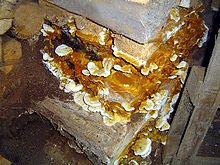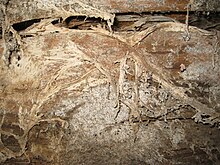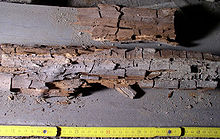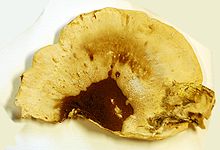Real dry rot
| Real dry rot | ||||||||||||
|---|---|---|---|---|---|---|---|---|---|---|---|---|
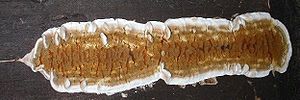
Fruiting body of a dry rot |
||||||||||||
| Systematics | ||||||||||||
|
||||||||||||
| Scientific name | ||||||||||||
| Serpula lacrymans | ||||||||||||
| ( Wulfen ) Schröt. |
The real dry rot ( Serpula lacrymans ) is a wood-destroying fungus . In addition to the brown cellar sponge ( Coniophora puteana ), it is a major cause of damage from sponge infestation in buildings. The dry rot preferentially infects built-up wood and needs a moist and not too cool environment for growth. Since it is not uncommon to see guttation droplets on it, it is also often called a watery dry rot .
Way of life
The dry rot is a wood-destroying fungus and a representative of the house rot fungi with the highest risk potential on buildings. In Central Europe, the fungus causes around 32% of building damage caused by fungi. Like all house rot fungi , the real dry rot is a brown rot fungus and is therefore dependent on materials containing cellulose . In addition to wood, the fungus can also be found on other organic materials such as a. Textiles , paper , chipboard , straw and reeds are good conditions for growth.
The real dry rot is exposed to many different growth factors. He finds favorable conditions for the beginning of growth at 35 to 60% wood moisture . The widespread opinion that dry rot can infect wood with moisture levels below 20% by transporting the necessary water in its strands has not been proven. However, since the moisture content of built-in wood, especially in inhabited buildings, is between 10 and 15%, humidity that is acceptable for the fungus only occurs under special conditions. These include u. a. the condensation points at z. B. wooden beam heads or defects (leaks).
In addition to the moisture in the substrate, temperature also plays an important role in fungal growth. The optimum temperature of the mushroom is between 18 and 22 ° C. However, above a temperature of 26 ° C, the fungus suddenly stops its physiological activity.
With very vital and large-scale growth, the fungus excretes drops of water (guttation drops). These "tears" (Latin: lacrima) gave it its name, but are also formed by other types of fungus. If large mycelium plexuses are exposed and exposed to light and fresh air, the fungus can develop spontaneous fruit bodies relatively quickly. However, if the draft is too strong, the mycelium can also die.
The high risk potential that the dry rot is derived from its special abilities: the fungus is able to overgrow or penetrate inorganic material. So the mycelia of the fungus masonry, plaster, fillings u. a. through or undergrowth. Based on these observations, this fungus is also often referred to as the “wall sponge”.
Oak is not a good substrate for the fungus, it is more likely to be overgrown. The tannic acids and other ingredients act as natural fungicides . However, it (seldom) happens that fruit bodies form on oak stairs (hidden soffits).
Damage pattern
As a typical surface fungus, the real dry rot forms a well-developed surface mycelium. However, its hidden growth means that its presence remains hidden for a long time, and carries the risk that load-bearing construction timbers will be decomposed by the dry rot without this fact being recognized. An infestation of wood is usually accompanied by an intense, coarse brown rot . If the infestation is advanced, the wood is broken into cubes and can be pressed in by hand. The brownish and white-rimmed pita-shaped fruiting bodies, which are covered with rust-brown hymenia , are characteristic. The fruit bodies often grow visibly on the substrate and are characterized by a sharply delimited growth margin of the surface mycelium with white-gray strands up to 1 cm thick. In rooms with low air circulation and high humidity, such as a. Basement rooms, the fungus can develop an extremely voluminous aerial mycelium. Another characteristic of the brown rot fungus is the immense production of spores.
The first perception of the fungus on surfaces may have been preceded by years of growth in cavities.
Combating and preventing damage
An infestation by the real dry rot can be recognized by its typical mycelia , strands and fruiting bodies . The aerial mycelium is white, translucent, even on masonry. In case of doubt, a molecular biological or microscopic examination can be useful.
The infestation with real dry rot is notifiable in some federal states. It is a serious construction defect according to the BGB. According to DIN 68800, part 4 (wood protection; control measures against wood-destroying fungi and insects), the infestation and the extent of the infestation must be determined by an expert (preparation of a wood protection test report). As a rule, such experts also develop renovation proposals.
The control must be carried out by an authorized specialist company (expert). The DIN 68800-4 in connection with the WTA leaflet The real dry rot gives renovation recommendations. This work should also be monitored by a specialist.
The real dry rot is by far the most difficult wood-destroying fungus to fight, as it can also attack relatively dry wood and also grow through masonry. It is controversial whether drafts interrupt growth. The fungus needs a certain, albeit low, moisture supply, but then it sometimes grows very quickly, usually undetected and unnoticed. The remains of the fungus can survive for many decades even in a dry state. The renovation must go hand in hand with the drainage of the masonry and wooden structure and can therefore be extensive. In the case of advanced infestation, it is often only necessary to replace the entire wooden structure.
Identifying the pathogen is the first step in sponge rehabilitation. If the affiliation is not clear, the procedure must always be as if there was a dry rot infestation: Infested wooden parts are removed with a safety distance of one meter. Pouring should be removed up to a safety distance of 1.5 m. Extensively infected masonry is rehabilitated by soaking holes or injecting masonry with a sponge barrier agent. Newly installed wood may have to be impregnated as a preventive measure in accordance with DIN 68800, Part 3. The affected area must dry well after the renovation.
In order to remove mycelium residues from the surface, it is often recommended to flame the masonry. It is also necessary to find and eliminate the cause of the source of moisture in order to avoid renewed fungal attack. If structural measures ensure that the affected wood and masonry are dry and will also remain dry in the future, the renovation effort can also be reduced in individual cases under the guidance of an expert. Without moisture, the dry rot stops its metabolism and no longer destroys wood. However, it remains in the component and, if moisture is present, quickly becomes active again decades later.
In order to reduce the risk of carry-over, careful disposal of the removed wooden parts and masonry sections is necessary.
The hot-air process is also often used to protect cultural and historical buildings as part of the renovation. This process is based on the fact that the fungus dies at temperatures above 50 ° C. However, this method reaches its limits in large rooms or with thick masonry.
The real dry rot was voted mushroom of the year by the German Society for Mycology in 2004 in order to emphasize its often underestimated economic importance.
research
The results of an in vitro experiment indicate the use of the real dry rot as a possible source for antibiotics .
See also
literature
- Tobias Huckfeldt: Ecology and cytology of the real dry rot (Serpula lacrymans) and other house rot fungi . Communications from the Federal Research Center for Forestry and Wood Management Hamburg, No. 213.Wiedebusch, Hamburg 2003, 152 pp.
- Tobias Huckfeldt, Olaf Schmidt: House rot and timber fungi. Diagnose und Sanierung Verlag Rudolf Müller, Cologne 2006, ISBN 3-481-02142-9 , 377 pp.
- Dietger Grosser: Plant and animal construction and timber pests. DRW-Verlag, Leinfelden-Echterdingen 1985, ISBN 3-87181-312-5 , 159 pp.
- Research project E-1998/14: Practice-oriented studies to combat the real dry rot (Serpula lacrimans) according to DIN regulations and alternative thermal methods. Munich 2005.
- Klaus Kempe: Wood pests. 3. edit u. exp. Edition. Verlag Bauwesen, Berlin 2004, ISBN 3-345-00827-0 .
- Hans-Peter Sutter: Recognizing and combating wood pests on cultural assets. 4th edition. Haupt Verlag, Bern 2002, ISBN 3-258-06443-1 .
- Werner Bavendamm: The dry rot and other wood fungi - detection and determination, prevention and control. G. Fischer, Stuttgart 1969, ISBN 3-437-30003-2 , 69 pp.
- WTA ( Scientific-Technical Working Group for Building Preservation and Monument Preservation ), (Ed.): Merkblatt 1-2-05 / D Der Echte Hausschwamm IRB Verlag, 2005.
- Uwe Wild: Lexicon of wood protection. BAULINO Verlag, Waldshut 2009, ISBN 978-3-938537-07-7 , 500 pp.
Individual evidence
- ↑ Tobias Huckfeldt, Olaf Schmidt: House rot and timber fungus: Diagnosis and remediation . Müller, Cologne 2006, ISBN 3-481-02142-9 , pp. 36 .
- ↑ Tobias Huckfeldt, Olaf Schmidt: House rot and timber fungus: Diagnosis and remediation . Müller, Cologne 2006, ISBN 3-481-02142-9 , pp. 166 .
- ↑ Dr-Dicht Holz- und Bautenschutz.Retrieved on February 10, 2015.
- ↑ Hans-Joachim Rüpke, Dr. Ernst Kürsten: Procedure for fighting dry rot , In: Holzfragen.de; accessed in April 2019.
- ↑ Janeš, D., Umek, A., Kreft, S. (2006). Evaluation of antibacterial activity of extracts of five species of wood-colonizing fungi. J. Basic Microbiol., 46, 3: 203-207.
Web links
- The real dry rot - occurrence, risks, damage and control measures , FLUGS specialist information service at the Helmholtz Zentrum München, German Research Center for Environment and Health (184 kB; PDF file)
- Images on holzfragen.de
- Real dry rot as mushroom of the year of the DGfM
